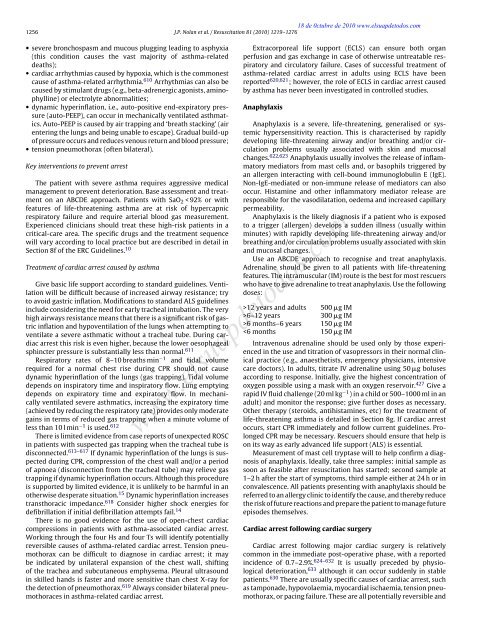European Resuscitation Council Guidelines for Resuscitation ... - CPR
European Resuscitation Council Guidelines for Resuscitation ... - CPR
European Resuscitation Council Guidelines for Resuscitation ... - CPR
You also want an ePaper? Increase the reach of your titles
YUMPU automatically turns print PDFs into web optimized ePapers that Google loves.
18 de 0ctubre de 2010 www.elsuapdetodos.com1256 J.P. Nolan et al. / <strong>Resuscitation</strong> 81 (2010) 1219–1276• severe bronchospasm and mucous plugging leading to asphyxia(this condition causes the vast majority of asthma-relateddeaths);• cardiac arrhythmias caused by hypoxia, which is the commonestcause of asthma-related arrhythmia. 610 Arrhythmias can also becaused by stimulant drugs (e.g., beta-adrenergic agonists, aminophylline)or electrolyte abnormalities;• dynamic hyperinflation, i.e., auto-positive end-expiratory pressure(auto-PEEP), can occur in mechanically ventilated asthmatics.Auto-PEEP is caused by air trapping and ‘breath stacking’ (airentering the lungs and being unable to escape). Gradual build-upof pressure occurs and reduces venous return and blood pressure;• tension pneumothorax (often bilateral).Key interventions to prevent arrestThe patient with severe asthma requires aggressive medicalmanagement to prevent deterioration. Base assessment and treatmenton an ABCDE approach. Patients with SaO 2 < 92% or withfeatures of life-threatening asthma are at risk of hypercapnicrespiratory failure and require arterial blood gas measurement.Experienced clinicians should treat these high-risk patients in acritical-care area. The specific drugs and the treatment sequencewill vary according to local practice but are described in detail inSection 8f of the ERC <strong>Guidelines</strong>. 10Treatment of cardiac arrest caused by asthmaGive basic life support according to standard guidelines. Ventilationwill be difficult because of increased airway resistance; tryto avoid gastric inflation. Modifications to standard ALS guidelinesinclude considering the need <strong>for</strong> early tracheal intubation. The veryhigh airways resistance means that there is a significant risk of gastricinflation and hypoventilation of the lungs when attempting toventilate a severe asthmatic without a tracheal tube. During cardiacarrest this risk is even higher, because the lower oesophagealsphincter pressure is substantially less than normal. 611Respiratory rates of 8–10 breaths min −1 and tidal volumerequired <strong>for</strong> a normal chest rise during <strong>CPR</strong> should not causedynamic hyperinflation of the lungs (gas trapping). Tidal volumedepends on inspiratory time and inspiratory flow. Lung emptyingdepends on expiratory time and expiratory flow. In mechanicallyventilated severe asthmatics, increasing the expiratory time(achieved by reducing the respiratory rate) provides only moderategains in terms of reduced gas trapping when a minute volume ofless than 10 l min −1 is used. 612There is limited evidence from case reports of unexpected ROSCin patients with suspected gas trapping when the tracheal tube isdisconnected. 613–617 If dynamic hyperinflation of the lungs is suspectedduring <strong>CPR</strong>, compression of the chest wall and/or a periodof apnoea (disconnection from the tracheal tube) may relieve gastrapping if dynamic hyperinflation occurs. Although this procedureis supported by limited evidence, it is unlikely to be harmful in anotherwise desperate situation. 15 Dynamic hyperinflation increasestransthoracic impedance. 618 Consider higher shock energies <strong>for</strong>defibrillation if initial defibrillation attempts fail. 14There is no good evidence <strong>for</strong> the use of open-chest cardiaccompressions in patients with asthma-associated cardiac arrest.Working through the four Hs and four Ts will identify potentiallyreversible causes of asthma-related cardiac arrest. Tension pneumothoraxcan be difficult to diagnose in cardiac arrest; it maybe indicated by unilateral expansion of the chest wall, shiftingof the trachea and subcutaneous emphysema. Pleural ultrasoundin skilled hands is faster and more sensitive than chest X-ray <strong>for</strong>the detection of pneumothorax. 619 Always consider bilateral pneumothoracesin asthma-related cardiac arrest.Extracorporeal life support (ECLS) can ensure both organperfusion and gas exchange in case of otherwise untreatable respiratoryand circulatory failure. Cases of successful treatment ofasthma-related cardiac arrest in adults using ECLS have beenreported 620,621 ; however, the role of ECLS in cardiac arrest causedby asthma has never been investigated in controlled studies.AnaphylaxisAnaphylaxis is a severe, life-threatening, generalised or systemichypersensitivity reaction. This is characterised by rapidlydeveloping life-threatening airway and/or breathing and/or circulationproblems usually associated with skin and mucosalchanges. 622,623 Anaphylaxis usually involves the release of inflammatorymediators from mast cells and, or basophils triggered byan allergen interacting with cell-bound immunoglobulin E (IgE).Non-IgE-mediated or non-immune release of mediators can alsooccur. Histamine and other inflammatory mediator release areresponsible <strong>for</strong> the vasodilatation, oedema and increased capillarypermeability.Anaphylaxis is the likely diagnosis if a patient who is exposedto a trigger (allergen) develops a sudden illness (usually withinminutes) with rapidly developing life-threatening airway and/orbreathing and/or circulation problems usually associated with skinand mucosal changes.Use an ABCDE approach to recognise and treat anaphylaxis.Adrenaline should be given to all patients with life-threateningfeatures. The intramuscular (IM) route is the best <strong>for</strong> most rescuerswho have to give adrenaline to treat anaphylaxis. Use the followingdoses:>12 years and adults 500 g IM>6–12 years 300 g IM>6 months–6 years 150 g IM
















